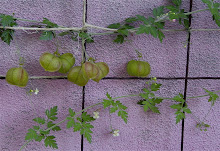


Anemopsis californica - Yerba Mansa, starting to bloom, April 19th, in my front pond.
Taxonomy: Magnoliophyta (angiosperm), Magnoliopsida (dicot), Saururaceae Common names: lizard tail, yerba mansa |
Anemopsis californica, is also known as yerba mansa. Yerba, is spanish for herb and mansa is the feminine form of the spanish word manso meaning tame, tranquil or calm.
Medicinal Uses: Although yerba mansa is not related to golden seal chemically or botanically it can be used similarly to treat inflammation of the mucous membranes, swollen gums and sore throat (Moore, 1989). This is important because golden seal, a popular herbal remedy, is in danger of becoming extinct in the wild due to exploitation. Properly managed, substituting yerba mansa could take some of the pressure off of the market for golden seal. An infusion of roots can be taken as a diuretic to treat rheumatic diseases like gout by ridding the body of excess uric acid, which causes painful inflammation of the joints. Yerba mansa prevents the buildup of uric acid crystals in the kidneys which could causes kidney stones if left untreated. Yerba mansa's general antiinflammatory effect makes it excellent for treating arthritis and other inflammatory diseases (Moore, 1989). A tea of roots used as a douche treats venereal sores, uterine cancer and is used after childbirth to staunch excessive bleeding. Yerba mansa is heralded for a variety of uses concerning childbirth. A sitz bath of one teaspoon tincture to one quart of water will quicken perineum healing after tearing or episiotomy during birth. The plant also has anti-fungal properties and a powder of dried root can be sprinkled on infected areas to alleviate athlete's foot or diaper rash (Kay, 1996). Yerba mansa is versatile, it can be taken orally as a tea, tincture, infusion or dried in capsule form. It can be used externally for soaking inflamed or infected areas. It can be ground and used as a dusting powder. Some people in Las Cruces, NM use the leaves to make a poultice to relieve muscle swelling and inflammation. |
People who have used this plant:
Yerba mansa has been used by many people the Pima, Mayo, Yaqui, Mexican, Chumash and Shoshone among them (Kay, 1996). I found no specific information on cultural practices concerning yerba mansa. Most sources indicate that the plant has been used by many groups in the southwestern United States. Margarita Artschwager Kay, author of Healing With Plants in the American and Mexican West, cites yerba mansa as having more entries in her notes than any other species in the American and Mexican west. | Non-medicinal Uses:
In the deserts of California yerba mansa is being used as turf in public parks and ground cover in gardens (Bakker, 1988). When yerba mansa populates an area it broadens the ecology as decaying leaf matter and root oils acidify and aerate the soil and inhibit the growth of harmful microorganisms (Moore, 1989). |
Active Ingredients
The active compound in Yerba mansa is methyleugenol, an antispasmodic, similar in chemical structure to compounds found in nutmeg which is used to treat irritable stomach (Fleming, 1998). |
|




No comments:
Post a Comment